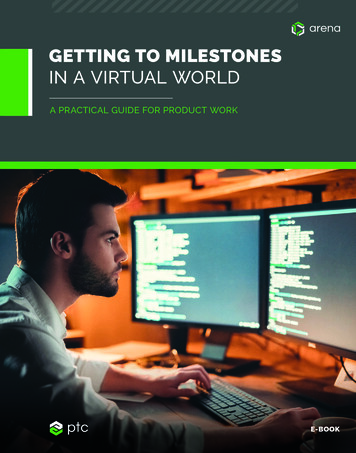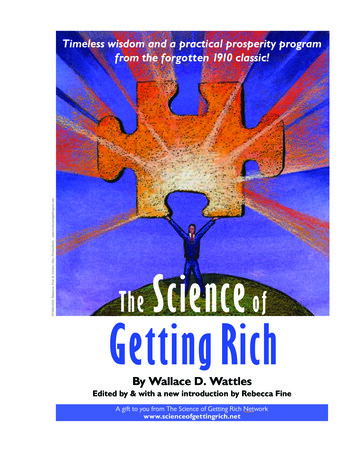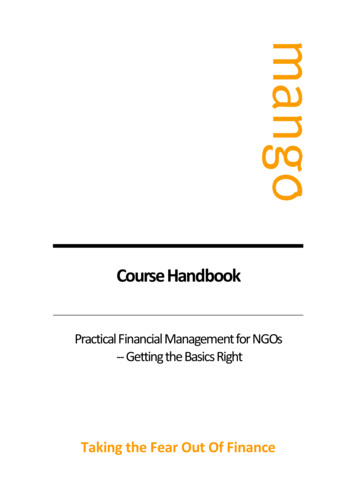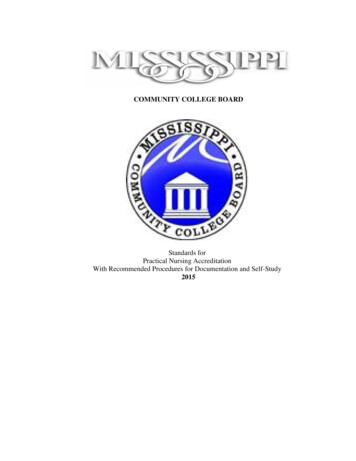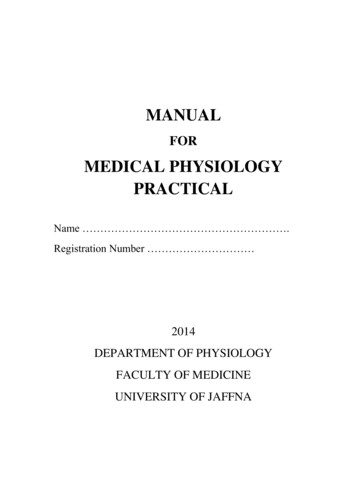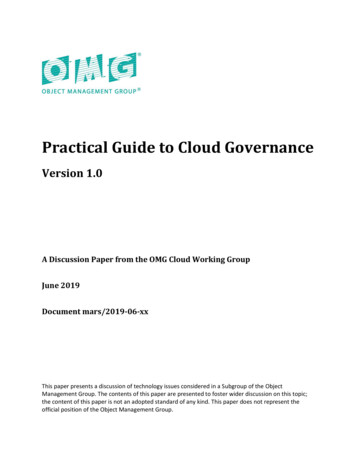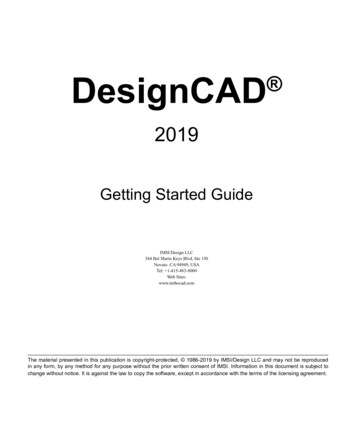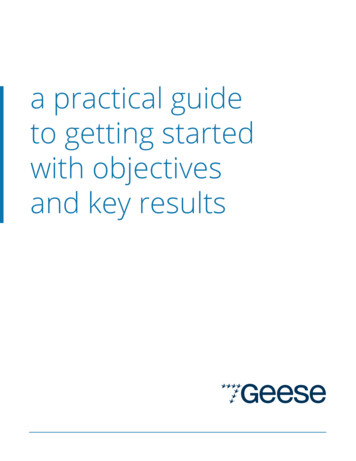
Transcription
a practical guideto getting startedwith objectivesand key results
ContentsSECTION 1 - GOAL SETTING: AN INTRODUCTIONObjectives and Key Results, an introduction . 4Evolution of goal setting . 5How OKRs are different than S.M.A.R.T. goals and MBOs . 6Create in-sync, intuitive teams with direct ownership over success . 7With a 3 month cadence, okrs create regular culture checks . 8SECTION 2 - WRITING OKRSOKRs reflect business priorities, as well as organizational culture . 9What okrs are and are not .10Rolling out OKRs: best practices .11The blueprint of a great OKR .12.13The difference between task management and OKRsTransforming tasks and projects into great OKRs: an example .14Using key performance indicators in your OKRs .15Metric classifications: baseline and threshold metrics .16Grading and assessing OKRs .17Aligning objectives begins with a vision and business purpose .18SECTION 3 - CREATING ALIGNMENT AND AQUARTERLY PLANNING PROCESSBest practice for linking okrs to performance evaluations . 20Great OKRs rely on a great planning process . 21Utilize the power of a conversation . 22A great OKR is a goal that people want to look at everyday . 23page 2 of 26Chat with 7Geese hello@7geese.com
goal-setting: anintroduction
Objectives and Key Results,an introductionOBJECTIVES AND KEY RESULTS IS A GOAL-SETTINGMETHODOLOGY DRIVEN BY OUTCOMESIn business, OKRs are used to guideoutcome-based success.Using outcomes instead of tasks as a driver,OKRs encourage accountability in every stepof achieving success through metricindicators. OKRs are driven by values-basedoutcomes.This e-book will provide an understanding ofwhat a great OKR is and how to write them,as well as what a great planning processlooks like so you can get started withgoal-setting in your own team!page 4 of 26OKRS OCCUR RHYTHMICALLYFollowing a cyclical planning cadence, thefocus of goals moves from tasks to results,keeping priorities and everyone’s thinkingdisciplined.A SUPPORTIVE ATMOSPHERE IS CREATEDSuccess isn’t just about reaching goals, butalso about creating a culture of coaching.OKRs enable accurate communication.EVERYONE IS ACCOUNTABLEBeing more than a declaration to accomplisha project, teams using OKRs figure out whatreally matters, together.Chat with 7Geesehello@7geese.com
Evolution of goal-settingGOAL-SETTING ISN’T NEW. THERE’S ALWAYS BEENTEAMS WORKING TOWARDS PRIORITIESThe process of settinggoals is notsomething new. It’s a key ingredient,alongside coaching environments, to highperforming teams. Regardless of theapproach taken to goal-setting, the endresult is to drive excellence and maintainalignment of efforts to business priorities.Here’s an overview of how goals haveevolved over the years.S.M.A.R.T GOALS 1954S.M.A.R.T stands for goals that are specific,measurable, attainable, relavent andtime-bound. With specifically measuredtargets, areas of improvement become easyto identify with S.M.A.R.T Goals. Goals arecreated in a targeted fashion to beassignable to an employee to accomplish, ina realistic and time-bound manner.page 5 of 26MANAGEMENT BY OBJECTIVES 1981Moving from an individual model to a morecollaborative approach, MBO is agoal-settingmodelthatintroducessolutions to ensuring a more real-timeperformance system. Moving towards aresponsive approach, MBOs value thenature of shifting priorities.However,with MBOs, performanceevaluations is linked to tasks, not goaloutcomes. Executives establish prioritiesand department leads are responsible foraligning their team efforts. There’s no clearline of sight into career growth fornon-executive employees.Chat with 7Geesehello@7geese.com
How OKRs are different than SMARTgoals and MBOsVALUES-DRIVEN OUTCOMES CREATE ANEMPLOYEE-DRIVEN ATMOSPHERETypical business goal-setting strategiesassume setting goals once a year is aneffective way to manage business priorities.Today’s workforce is agile and crave a highrate of feedback. OKRs create a supportiveenvironment where coaching has a strongcorrelation to high employee engagement.OKRS INCREASE TEAM AGILITYTraditional goal-setting assumes employeesshould set goals independently of oneanother based on their direct responsibilitiesand deliverables.With OKRs, team efforts become alignedunder a common organizational priority andcore values. But in team settings, it’simportant to keep efforts in sync, especiallywith an increase in agile development.Cross-functionalteamsuccessandpage 6 of rganizationsbecome an inclusive place where the inputof others is valued.GOALS ARE DECOUPLED FROMPERFORMANCE BONUSESEveryone works harder and aims higherwhen goals become decoupled fromcompensation. Teams are empowered towork harder. Performance isn’t tied solely tometrics so employees are able to focus onsuccess and growth, not just quantity.Teams can focus on quality performance,not just meeting a target. Personaleffectiveness increases since goals becomechallenging. Organizations stay ahead,moving beyond just meeting the status quo.Chat with 7Geesehello@7geese.com
Create in-sync, intuitive teams withdirect ownership over successKEEP TEAMS FOCUSED, EMPOWERING INDIVIDUALSTO CONTINUOUSLY GROWALIGNED TEAMS INCREASE VISIBILITYWith OKRs, you don’t have to wait until thingsaren’t working well to jumpstart change. Thisbreaks the assumption that performanceneeds to be “managed,” moving focus onsharing organizational vision. With a deeperunderstanding of what their efforts areworking to achieve, employees becomeequals, not slots in a hierarchical tree.Everyone is able to see how priorities areprogressing at an individual level, all the wayup to if the organization is on track as awhole. This creates a visual where teams canreflect on roadblocks, assess current actionsand easily document next steps.clear expectations for all interactions. Thisinspires cross-functional team growth.EVERYONE’S PERSONALLY INVESTED ANDACCOUNTABLE FOR SUCCESSManagers can spend less time crunchingnumbers and more time using theirexpertise to coach. Everyone on the teamworks towards value-driven goals; everyoneis accountable. OKRs create an internalplatform for ongoing dialog in emconversationstieddirectly to their role within the team.OKRs take the guess work out of how eachrole impacts the next person. As a result ofincreased visibility, each team can createpage 7 of 26Chat with 7Geesehello@7geese.com
With a 3 month cadence, OKRscreate regular culture checksA PROCESS FOR DELIBERATING IF NEW IDEASSHOULD BE ABSORBED INTO EXISTING PRIORITIESOKRS USE METRIC INDICATORSWhen an objective has measurable key results,it’s easy to determine if the new idea fits in witha current strategy. If it can’t fit into the currentset of OKRs or be aligned effortlessly, you'reforced to make an exception or reprioritize.OKRs force constant deliberation, keeping yourorganization’s strategy fresh.ALIGNED TEAMS COMMUNICATE BETTERWith OKRs, transparency is inherent. Teamsare positioned to know what is important to theorganization at all times, meaning they canbecome more agile. Effective adaptabilitymeans frequent assessment on priorities andreplaces a static, annual review of strategy.This makes it easy to adjust prioritiesthroughout the year without having to getcaught up in any potential backlogs.page 8 of 26Chat with 7Geesehello@7geese.com
writing OKRs
OKRs reflect business priorities as wellas organizational cultureA GREAT OBJECTIVE CLEARLY ANSWERS,“WHO IS RESPONSIBLE FOR WHAT?”OKRs are designed to get teams excited by asense of meaning, purpose, and progress.When employees clearly understand what isexpected of them, politics and favoritism areminimized, and everyone can collectively focuson executing business strategy.Objectives are single sentences that describecurrent business priorities in the language andculture of your team. Accompanying resultsshould be difficult, but not impossible. You arelooking for the sweet spot between pushingyou and your team to do bigger, innovativethings and where you can still move forwardproductively.If you’re saying, “This seems doable if we reallypush ourselves this quarter ” - you’re doingOKRs right.page 10 of 26Chat with 7Geesehello@7geese.com
What OKRs are and are notEVERY ORGANIZATION MIGHT HAVE A DIFFERENTINTERPRETATION, BUT THE APPROACH STAYS THE SAMEThe goal of incorporating metric-drivenresults is to measure and gauge movementtowards or away from success.The aim of setting OKRs is to have everyoneunderstand how their efforts are making abigger impact on overall team success. OKRshelp teams spend less time being distractedby tasks, and more time achieving success.OKRS ARE NOT.- Unspecific goals with a task list- Boring and monotonous- Overly specific to be constraining- A statement that notes a business vision- A one-size fits all model- General actions you plan to takeINSTEAD, THEY ARE.Reminders why you do what you doday-to-day, regardless of your role.Aspirational and challenge you to beinnovative and creative, a better you.Written so anyone can understand howyou’re contributing to business strategiesand priorities.Aligned to organizational values.page 11 of 26Chat with 7Geesehello@7geese.com
Rolling out OKRs: best practicesBEST PRACTICES INFORMING THE ROLLING-OUT OFOKRS TO YOUR TEAMSETTING THE RIGHT CADENCEOKRs are defined by measurable targets thatoccur within rhytmic time frames. Quarterly,every three months beginning in January, ismost common. However, objectives on anylevel can always be stretched quarter overquarter if the impact on success of anobjective is more long-term.While quarterly is recommended, it isimportant the cadence matches the cultureof the business. The key to OKRs is thetransition from annual assessments to morefrequent and transparent goal setting.continuous basis, not just at the end of thequarter or end of the year.TEAM AND INDIVIDUAL BEST PRACTICESEvery OKR should reflect realistic prioritiesachievable in a three-month-cycle that arestill challenging. Make sure to haveconversations that answer what successmeans in relation to how each team needsto support the others.AWARENESS ISN'T VALUABLE - IT'S HOWYOU WIELD ITBe sure to discuss how you will grade yourOKRs before you set them. Setting clearexpectations will help with assessments on apage 12 of 26Chat with 7Geesehello@7geese.com
The blueprint of a great OKROBJECTIVES EMPOWER COLLABORATION ANDCROSS-FUNCTIONALITYAll objectives should have a due date - thistypically happens quarterly. It’s important toset a due date that fits both with thepriorities of your organization, as well as theculture and pace of your team.OBJECTIVE CRITERIAObjectives reflect outcomes that arechallenging, but realistic. There’s an inherentsense of collaboration with a great objectivewhere teams can cross-collaborate.If the organizational priority is to achieveproduct-market fit, everyone on the teamcan see that and see how they can focustheir efforts towards it. Since an objective isa sentence, there should be a clear subject,object and journey the subject goes through.KEY RESULT CRITERIAGreat key results are numerically measured.They utilize metric-centric indicators such askey performance indicators. Great keyresults focus on measuring an end result ofa series of tasks, but aren’t tasks themselves.A great key results answers, “how do I know ifI have achieved my outcome?”AN EXAMPLE OF A GREAT OKRObjective: Customers consistently find ourproduct useful.KR 1: 80% of new customers continue theirsubscription after 2 months.KR 2: 50% of users return within 2 weeks.KR 3: Churn rate is 2% this quarter.A great objective answers, “what am I workingtowards without focusing on the tasks?”page 13 of 26Chat with 7Geesehello@7geese.com
The difference between taskmanagement and OKRsOKRS ARE THE OUTCOME OF ALL THOSE TO-DOSIT’S THE RESULTS THAT MATTERTasks are small, bite-sized chunks of aroad-map that lead to the results you trackin your OKRs. Measuring results, not tasksmoves conversations away from, “what steps(task) am I going to take to complete thisoutcome,” to, “what am I expecting to achieve ifI successfully complete this objective? Whattarget indicator will define success?”The aim of OKRs is to have a bigger impactby splitting time on fewer things andfocusing on results, not tasks. OKRsencourage discussion on how one person’sobjectives impact the rest of the team.TRANSLATING TASKS INTO OKRSOnce you’ve established what result you’rehoping to achieve, think to the supportingprojects that you’re going to perform to getpage 14 of 26you there. From there, think further andmore specifically down to the tasks tocomplete that project. Tasks often changeday-to-day, as they are short bursts that helpyou assess what is working and what’s not.You can cross them off a sticky note, to-dolist, or mark as complete/incomplete. Theytypically don’t measure success.TASKS CAN’T BE GRADED OR ASSESSEDThis is why it’s important to try steer clear ofmaking tasks a key result - they can’t begraded. The conversation then becomes “didyou hit your target? yes or no?” not “how didyou perform, what were the roadblocks youfaced, did you aim too high? Were yousupported in achieving your results?”Chat with 7Geesehello@7geese.com
Transforming tasks and projects intogreat OKRs: an exampleOBJECTIVE: POTENTIAL CUSTOMERS UNDERSTAND OURINDUSTRY’S BEST PRACTICEKEY RESULTDevelop role-specific content & campaigns to engage andretain existing users, increasing adoption rate by 10%PROJECT #1Webinar on best practicesTask 1: Create campaign to engage customersTask 2: Execute webinar, analyzing resultsPROJECT #2Write 5 blog posts per monthTask 1: Write content on industry trendsTask 2: Write campaigns to send to existing leadsKEY RESULT5 companies successfully introduce a process they learntthrough our spotlight storiesPROJECT #1Write spotlight storiesTask 1: Identify highly engaged customersTask 2: Write and publish spotlight storyPROJECT #2Engagement campaignsTask 1: Create engagement campaignTask 2: Ship campaign, monitoring resultspage 15 of 26Chat with 7Geesehello@7geese.com
Using key performance indicatorsin your OKRsFOCUS ON THE RIGHT METRICS FOR GROWTHINCORPORATING THE RIGHT METRICSBEST PRACTICESOKRs focus on results, not tasks. Numericinsights move conversations from actionstaken, to data patterns across quarters. Thismeans teams can assess success patterns toreally measure the most valuable aspects ofa team’s efforts.Clearly define target metrics important toyour core values and business priorities. Thiswill keep employees engaged because youare linking outcomes to metrics that fit withthe culture and direction of the team.The most important component of using akey performance indicator (KPI) in an OKR isto make sure it is a valuable metric to theorganization. Adding a target number for thesake of abiding by the “metric-driven” aspectof a key result clouds the effectiveness ofyour key result.page 16 of 26Establish a baseline target of excellence andhow you’d like to move away or towards yourbaseline target.Discuss expectations on check-in cadenceand make sure it’s realistic for the KPI.Define what the feedback loop is for the KPI- if you have to wait more than the quarter toreceive feedback from your KPI data, try toavoid looping it in your OKR. If you don’t, youwon’t be able to effectively grade successalong the way.Chat with 7Geesehello@7geese.com
Metric classifications: baseline andthreshold metricsEVERY METRIC USED SHOULD MATCH YOUR TEAM’SCULTURE AND PRIORITIESAny metric used in key results should followthe S.M.A.R.T model - specific to thebusiness, measurable, attainable in the givencycle of the objective, relevant to your OKR,and time-bound.Negative metics are used when you want todecrease your baseline metric. Forexample, if your average support responsetime is 10 and you’d like it to be 4, you’removing in a negative direction.BASELINE METRICSTHRESHOLD TARGET METRICSA baseline metric is a single number that isconsidered an “acceptable” metric. Forexample, having a support ticket responsetime of 4 hours or less has a baseline KPI of4. Anything above 4 hours is unacceptable.Threshold metrics are a numerical rangethat is considered acceptable. Here’s anexample: sales needs to make a minimumof 90,000 in monthly reccurring revenuefor the business to stay cash flow even. Forthe business to be cash flow positive, thereccurring revenue must be over 110,000per month.POSITIVE AND NEGATIVE METRICSA positive metric is used when you want toincrease your baseline metric. For example,if your average usability score for a coreworkflow in your product is currently 70%and you want to increase it to 80%, you’removing in a positive direction.page 17 of 26This is a threshold target metric since itspecifies an acceptable low and high values,creating a range of metric-centric goals thatare acceptable.Chat with 7Geesehello@7geese.com
Grading and assessing OKRsCREATE CLEAR EXPECTATIONS USING A GRADESCHEMA TO ASSESS YOUR OKRSA ONE SIZE FITS ALL GRADING APPROACHIS NOT THE BEST APPROACHOKRs can be very different for differentteams and functional positions. It’simportant to consider the difficulty of eachOKR when grading and assessing. It’simportant to establish a grading scale beforecommitting to an OKR to ensureexpectations throughout the quarter areclearly defined.RED OR GREEN: MEETING EXPECTATIONSA great place to start with grading isproviding a simple expectations assesment:at the end of the quarter, did you meet theexpectations for your OKR that youcommitted to?page 18 of 26THE TRADITIONAL 0-1 KEY RESULT SCALEWhen grading OKRs the traditional way, therecommended scale is 0 - 1. For each of yourkey results, the highest it can score is a 1,and lowest a 0. OKRs are meant to bechallenging, so every individual should beaiming for a 0.6 - 0.7 in the grading process.After rating each of your KR, you can thenadd them all together. Any objective withcumulative scale of under a 0.4 might bealarming, but a low score isn’t a failure. It’s asign you need to re-evaluate whether theobjective is still worth pursuing, or rethinkyour approach. How you chose to assign agrade depends on the circumstances of yourteam’s priorities. Perhaps a 0.5/1 is greatbecause priorities shifted halfway throughthe quarter.Chat with 7Geesehello@7geese.com
Aligning objectives begins with a visionand business purposeA CLEAR PURPOSE AND ALIGNED TEAMS IS ANENGAGED TEAMCreating objectives can be done at any level,but an important component of making anobjective great is how it aligns with otherobjectives in the organization.A TOP-TO-BOTTOM PROCESS, WITH AFOCUS ON BOTTOM-UP EFFORTSEveryone is driven by business priorities andcore values - alignment keeps everyone’sagenda focused to what defines success forthe team as a whole. This also places a focuson bottom-up efforts, inspiring teamsthrough the visualization of how they’recontributing to business success.ESTABLISH A CLEAR DRIVING PURPOSECreating great OKRs depends on how wellyour team as a whole does in identifyingbusiness priorities. A customer support rep,for example, can’t set a great OKR if they areunsure what the entire support team isfocused on. And further, the support teamwon’t know what’s a priority if theorganization doesn’t set OKRs.Because of the higher-level focus of OKRsbeing driven by core values and businesspriorities, creating great OKRs means thatorganizational OKRs should be in place to bealigned up to.It’s important to link your objectives to a corevalue or purpose, to ensure you’re beingdriven by the right guide.page 19 of 26Chat with 7Geesehello@7geese.com
Best practice for linking OKRs toperformance evaluationsDECOUPLING GOALS AND PERFORMANCE ENABLESVALUE INNOVATIONOKRs, when done great, are a tool formotivating and aligning people to worktogether. They increase transparency,accountability, and empowerment. They arenot designed to be used as a weapon againstyour employees to keep tabs.LINKING THE TWO? HERE’S A FEW BESTPRACTICES TO KEEP IN MINDLinking incentives to goal-setting can lead tocompetition over collaboration, quantityover quality, and less innovative, challenging,and success stretching goal-setting.Link bonuses not solely to OKR performance,but other attribute criteria, such asprofessionalism brought to work, skillsacquired, the level of OKR difficulty, amongstother criteria.Have oversight over everyone’s OKRs toensuretheymeetcompany-wideexpectations and aren’t throwing theaspirational aspect of goals.Don’t base bonuses solely on whether or notan OKR was met. Incorporate OKRs into thediscussion about performance, but don’t letthem be the deciding factor for whether abonus is handed out or not.page 20 of 26Chat with 7Geesehello@7geese.com
creating alignmentand a quarterlyplanning process
Great OKRs rely on a greatplanning processANY GREAT PLANNING PROCESS PLACES EMPHASISON REFLECTION CONVERSATIONSTHERE HAVE TO BE CONVERSATIONSESTABLISHING A PLANNING TIMELINEIn order to create OKRs, commit to newones, or know what the current priorities are,there needs to be discussions on whathappened previously, what was learnt, andwhat you plan to do about it in the nextquarter. This holds everyone accountableboth retroactively, as well as in the future tomake sure course corrections are enabledwhere necessary.STEP 1: Leadership creates organizationalobjectives, distributing to all employees.TIMELINE: three weeks before quarter’s end.OKRs are inherently collaborative, meaningobjectives don’t occur in silos. The majority ofthe planning process’s end needs to focuson how each team is going to be supportingthe other, what resources are going to beneeded, and ask each other any questionson clarity if a team’s OKRs are unclear or notwell aligned.page 22 of 26STEP 2: Teams discuss how they will bringorg. objectives to life.TIMELINE: two weeks before quarter’s end.STEP 3: Team leads relay to everyone howtheir teams will align to org.objectives.TIMELINE: 1 week prior to step 4.STEP 4: ALL HANDS MEETING! Connect tofinalize and visualize everyone’s OKRs.TIMELINE: A few days before the quarter.Chat with 7Geese hello@7geese.com
Utilize the power of a conversationDISCUSSIONS FOCUS ON RISKS, BLOCKERS, ORRESOURCES NEEDED TO SUPPORT THE OKRSA few other things to keep in mind whenstarting with OKRs is to ensure you’rediscussing personal commitment levels. Areyou taking on too much? Too little? OKRs aresupposed to be challenging, but also realisticand doable within a quarter’s worth of time.REFLECT ON PERSONAL nt, especially for operational goalsthat are cross-functional. What one teamdefines as success may not be anotherteam’s vision. Sync up to discuss! Thereshould be no lack of understanding on, forexample, how an OKR supports anorganizational goal.Have conversations that answer whatsuccess means in relation to how each teamwill support the other, and what resourcesareneeded to make that support a success.page 23 of 26Every great planning day incorporates adiscussion where everyone gets asked ”canyou commit to all of this?”ASSESS CROSS-FUNCTIONAL GOALSHAVE ALIGNMENT CONVERSATIONSClearly discuss how goals will be tracked andhow everyone will be held accountable.Clear expectations are key.Chat with 7Geesehello@7geese.com
A great OKR is a goal that peoplewant to look at everydayGOAL-SETTING BECOMES HABITUAL AND NATURALWITH OKRSEvery month, every week - consistentlyengaging OKRs turn goal-setting into a habit.This changes how individuals approacheveryday jobs-to-be-done. Milestones becomenatural, focusing conversations on what youneed to do next to aim even higher.This will put in place natural milestones thatmake your organization continuously analyzewhat you need to aim higher and get theremore effeciently.WHAT’S AN EASY INDICATOR YOU’REDOING IT RIGHT?Overhearing people talking casually in thecontext of their OKRs. This is a sign that peoplefeel connected to the company and where it’sheaded. That’s how you know you’ve created agreat OKR process.page 24 of 26Chat with 7Geesehello@7geese.com
ready to start usingOKRs?Track, manage, and align your goals today.Learn more at www.7geese.com
contact us300-55 Water St.Vancouver, BC V6B 1A1Canadahello@7geese.com 1.800.280.2967 1.604.568.1296
Objectives and Key Results, an introduction Evolution of goal setting How OKRs are different than S.M.A.R.T. goals and MBOs Create in-sync, intuitive teams with direct ownership over success With a 3 month cadence, okrs create regular culture checks SECTION 2 - WRITING OKRS OKRs refle

